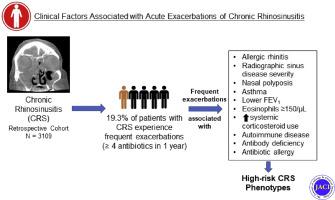Journal of Allergy and Clinical Immunology ( IF 11.4 ) Pub Date : 2020-01-29 , DOI: 10.1016/j.jaci.2020.01.023 Jason H Kwah 1 , Shaan N Somani 1 , Whitney W Stevens 2 , Robert C Kern 2 , Stephanie S Smith 3 , Kevin C Welch 3 , David B Conley 3 , Bruce K Tan 3 , Leslie C Grammer 1 , Amy Yang 4 , Robert P Schleimer 2 , Anju T Peters 2

|
Background
Chronic rhinosinusitis (CRS) is complicated by frequent acute exacerbations leading to significant health care burden and impaired quality of life.
Objective
The objective of this study was to identify clinical factors associated with frequent acute exacerbation of CRS (AECRS).
Methods
This is a retrospective cohort study of patients with CRS from January 1, 2014, to May 31, 2016. Frequent AECRS was defined as at least 4 episodes over a 12-month period in which an antibiotic was prescribed for worsening sinus symptoms, and infrequent AECRS was defined as 0 to 3 episodes. Clinical factors, including asthma, allergic rhinitis, eosinophil count of at least 150 cells per microliter, and autoimmune disease, were evaluated for associations between the 2 groups.
Results
Of the 3109 patients with CRS who were identified, 600 (19.3%) were classified as having frequent exacerbation. Asthma, allergic rhinitis, eosinophil count of at least 150 cells per microliter, and autoimmune disease were associated with frequent AECRS with statistically significant adjusted odds ratios (aORs) after controlling for age, race, and sex in multivariate analysis (asthma aOR = 2.61 [95% CI = 2.14-3.18]; allergic rhinitis aOR = 1.96 [95% CI = 1.58-2.42]; eosinophil count of at least 150 cells per microliter aOR = 1.54 [95% CI = 1.21-1.97]; and autoimmune disease aOR = 1.68 [95% CI = 1.36-2.07]). Antibody deficiency, antibiotic allergy, lower FEV1, radiographic sinus disease severity, nasal polyposis, and systemic corticosteroid use were also associated with frequent AECRS.
Conclusion
Patients with frequent episodes of AECRS were characterized by a higher prevalence of asthma, allergic rhinitis, eosinophil count of at least 150 cells per microliter, autoimmune disease, and other allergic and immunologic diseases. These findings identify a high-risk phenotype of patients with CRS for preventive interventions to reduce exacerbation frequency.
中文翻译:

与慢性鼻窦炎急性加重相关的临床因素。
背景
慢性鼻窦炎 (CRS) 因频繁急性加重而复杂化,导致重大的医疗保健负担和生活质量受损。
客观的
本研究的目的是确定与 CRS 频繁急性加重 (AECRS) 相关的临床因素。
方法
这是一项对 2014 年 1 月 1 日至 2016 年 5 月 31 日 CRS 患者的回顾性队列研究。频繁的 AECRS 定义为 12 个月内至少 4 次发作,其中抗生素用于恶化鼻窦症状,并且不频繁AECRS 定义为 0 到 3 次发作。临床因素,包括哮喘、过敏性鼻炎、嗜酸性粒细胞计数至少 150 个细胞/微升和自身免疫性疾病,对两组之间的关联进行了评估。
结果
在确定的 3109 名 CRS 患者中,600 名(19.3%)被归类为频繁恶化。在多变量分析中控制年龄、种族和性别后,哮喘、过敏性鼻炎、嗜酸性粒细胞计数至少 150 个/微升和自身免疫性疾病与频繁的 AECRS 相关,调整优势比 (aOR) 具有统计学意义(哮喘 aOR = 2.61 [ 95% CI = 2.14-3.18];过敏性鼻炎 aOR = 1.96 [95% CI = 1.58-2.42];嗜酸性粒细胞计数至少 150 个细胞/微升 aOR = 1.54 [95% CI = 1.21-1.97];和自身免疫性疾病 aOR = 1.68 [95% CI = 1.36-2.07])。抗体缺乏、抗生素过敏、较低的 FEV 1、放射学鼻窦疾病严重程度、鼻息肉和全身性皮质类固醇使用也与频繁的 AECRS 相关。
结论
频繁发作 AECRS 的患者的特点是哮喘、过敏性鼻炎、嗜酸性粒细胞计数至少 150 个细胞/微升、自身免疫性疾病和其他过敏性和免疫性疾病的患病率较高。这些发现确定了 CRS 患者的高风险表型,可用于预防性干预以减少恶化频率。











































 京公网安备 11010802027423号
京公网安备 11010802027423号